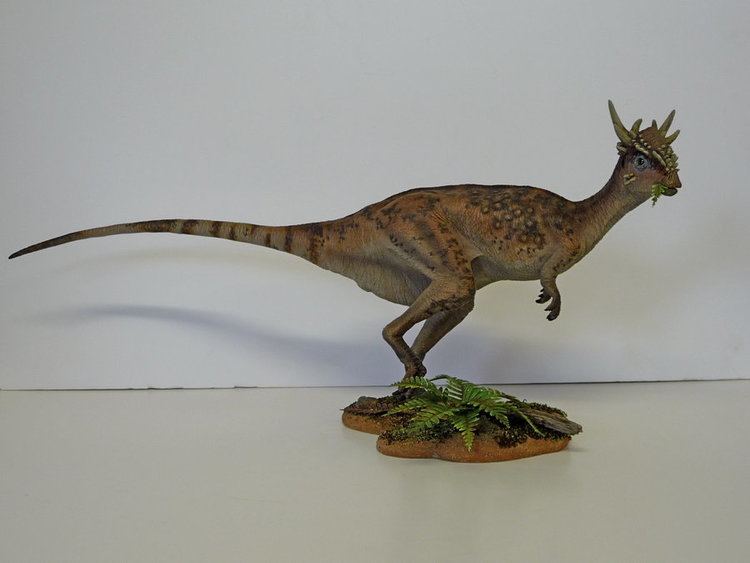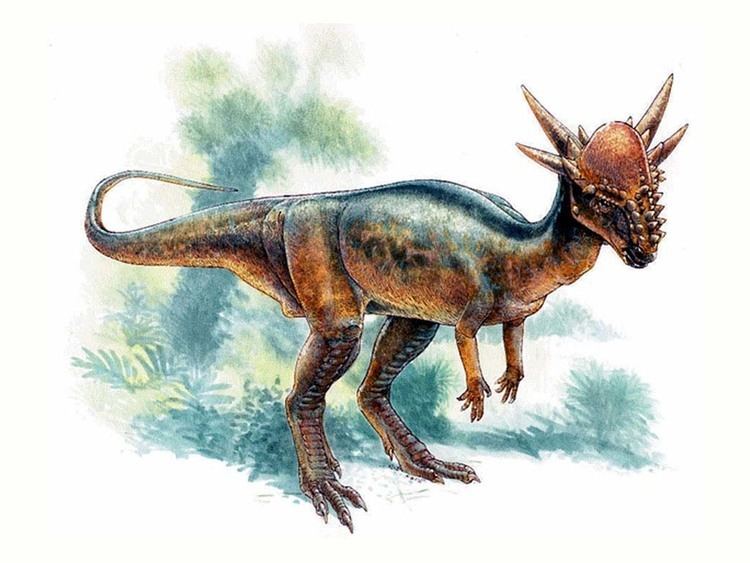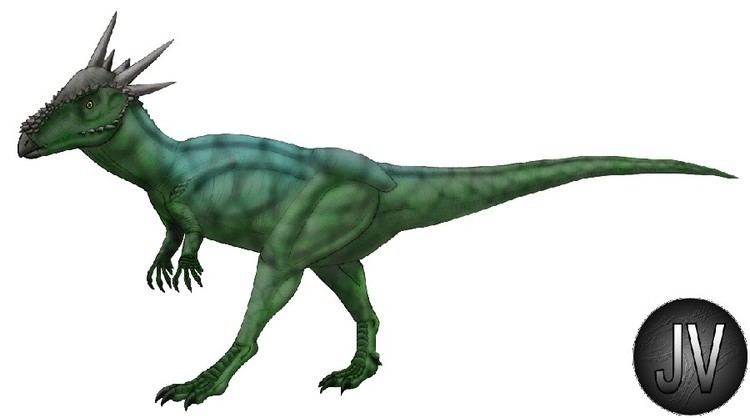Kingdom Animalia Clade Dinosauria Family †Pachycephalosauridae Scientific name Stygimoloch Rank Genus | Phylum Chordata Order †Ornithischia Species †S. spinifer Higher classification Pachycephalosauridae | |
 | ||
Similar Dinosaur, Dracorex, Pachycephalosaurus, Pachycephalosauria, Stegoceras | ||
Pivot animator stygimoloch rampage a mother s tale
Stygimoloch is a controversial genus of pachycephalosaurid dinosaur from the end of the Cretaceous period, roughly 66 million years ago. It is currently known from the Hell Creek Formation, Ferris Formation, and Lance Formation of the Western Interior (United States), where it lived alongside Tyrannosaurus and Triceratops.
Contents
- Pivot animator stygimoloch rampage a mother s tale
- Dino dan stygimoloch promo
- Description
- History of discovery
- Classification
- References

Dino dan stygimoloch promo
Description

It is a relatively large pachycephalosaur, with the skull being about 46 centimeters long (18 in). Among North American pachycephalosaurs, only Pachycephalosaurus is larger. Unlike other pachycephalosaurs, the domed skull is relatively small, slightly flattened from side to side, and pear-shaped; even when isolated this unusual dome can easily be distinguished from the broader, larger domes of Pachycephalosaurus. While the dome is reduced in size, the ornamentation over the skull is more elaborate than in any other pachycephalosaur. Short, conical hornlets covered the nose, and the back corners of the skull bore an enormous pair of massive, backward-pointing spikes, up to 5 centimeters in diameter (2 in) and 15 centimeters long (6 in); these are surrounded by two or three smaller spikes. The function of this unusual ornamentation is unknown. Even if other pachycephalosaurs did butt heads (which is a subject of continuing debate), the small dome of Stygimoloch suggests that this behavior was not as important. Instead, the skull ornament might have functioned for display, may have been used for self-defense, or perhaps were locked together and used in shoving matches, like the horns of deer. Another possibility is that the squamosal horns were used to inflict pain during flank-butting.
History of discovery

The type species, S. spinifer, was described by British vertebrate paleontologist Peter Galton and German paleontologist Hans-Dieter Sues of the National Museum of Natural History in 1983. Stygimoloch is characterized by clusters of spikes on the back of the skull, in which a long central horn is surrounded by 2-3 smaller hornlets, and a tall, narrow dome. Dracorex has similar but shorter hornlets and lacks a dome, and has been interpreted as either a distinct species, or a juvenile or female of Pachycephalosaurus or Stygimoloch. It has also been proposed that Stygimoloch represents partially grown individuals of Pachycephalosaurus.

The name Stygimoloch comes from the river Styx, which is said to run through the underworld in Greek Mythology, in reference to the Hell Creek Formation, and from Moloch, the name of a Canaanite god, chosen in reference to the bizarre appearance of the animal.
Classification
The pachycephalosaur Dracorex may actually be an individual of Stygimoloch or Pachycephalosaurus in which the dome and horns are not well-developed, either because the animal was a juvenile or because the animal was a female. This consideration was supported at the 2007 annual meeting of the Society of Vertebrate Paleontology. Jack Horner of Montana State University presented evidence, from analysis of the skull of the single existing Dracorex specimen, that this dinosaur may well be a juvenile form of Stygimoloch. In addition, he presented data that indicates that both Stygimoloch and Dracorex may be juvenile forms of Pachycephalosaurus. Horner and M.B. Goodwin published their findings in 2009, showing that the spike/node and skull dome bones of all three 'species' exhibit extreme plasticity, and that both Dracorex and Stygimoloch are known only from juvenile specimens while Pachycephalosaurus is known only from adult specimens. These observations, in addition to the fact that all three forms lived in the same time and place, lead them to conclude that Dracorex and Stygimoloch were simply juvenile Pachycephalosaurus, which lost spikes and grew domes as they aged. A 2010 study by Nick Longrich and colleagues also supported the hypothesis that all flat-skulled pachycephalosaurs were juveniles, suggesting that flat-skulled forms like Goyocephale and Homalocephale represent juveniles of dome-skulled adults.
